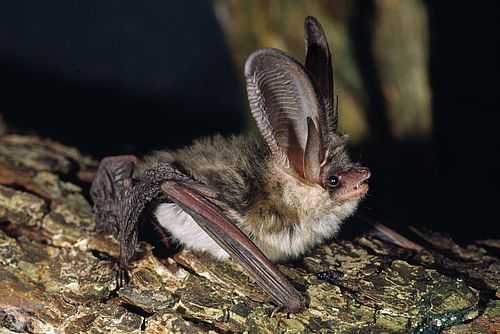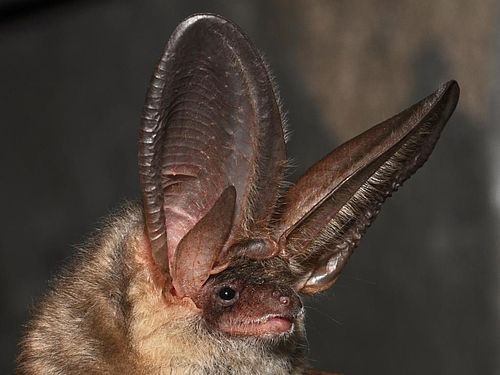species
- Barbastella
- Eptesicus
- Myotis
- Nyctalus
- Pipistrellus
- Vespertilio
Grey long-eared bat Plecotus austriacus
The grey long-eared bat (Plecotus austriacus) looks quite similar to the brown long-eared bat (Plecotus auritus). However, it is much less common and seems to be much more endangered.


characteristics
| habitat description | Found in woods, meadows, parks and, to a much greater extent than the brown long-eared bat, also in settlements and villages, gardens and parks. |
| quarters | Nursery roosts consist of 10-30 individuals, which are mainly found in buildings, in the southern distribution area also in caves, very rarely in bat boxes. Relatively cold-resistant species, hibernating from October to March at the entrance of cellars, caves, rock and building crevices. |
| reproduction | The birth of only one young usually occurs in the second half of June. First matings have been observed as early as the end of July. Swarming rather rarely in front of caves. |
| size | - Head-torso length: 43-55 mm - Forearm length: 36-43 mm - Wingspan: 250-290 mm |
| weight | 6-10 g |
| color/fur | Grey above, greyish-white below. Around the eyes dark brown to grey-black fur colour, the muzzle is dark grey. |
| ear shape | Very long. Are laid behind the wings during torpor and hibernation, so that only the lanceolate tragus is visible, which itself resembles a small ear. The tragus is grey and much darker than in the brown long-eared bat. |
| wing shape | Broad and short, roundish. |
| flight | Fluttering or shaking flight. Hunt mainly moths but also beetles when flying. Taking insect prey from the ground plays a less important role than for the brown long-eared bat. |
| ultrasonic calls | Frequency-modulated, dry calls with start frequencies at 35 - 55 kHz and end frequencies at 16 - 20 kHz. Main frequency at 23 - 28 kHz. Call intervals are very different, therefore very unrhythmic. Because the calls are very quiet, they leave a "whispering" auditory impression that is unique compared to the species of all other genera. Can be confused with the call of the brown long-eared bat. |
| endangerment | Especially in the north, the species is mainly found in roof trusses, so they are particularly affected by loss of roosts due to renovations. The use of pesticides also poses a greater threat. Red List of Germany (2020): Critically Endangered. IUCN (2016): Near Threatened. |